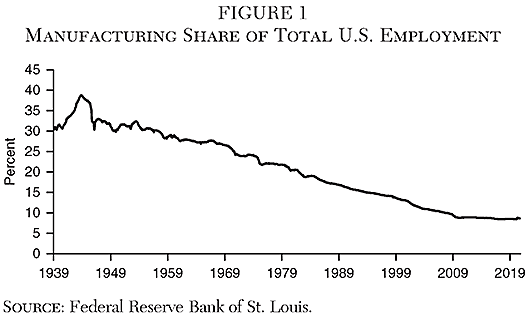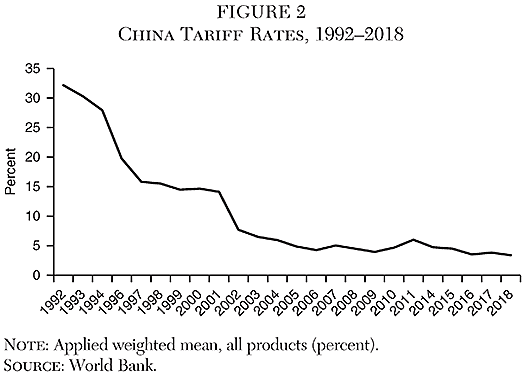Abel, J. and Deitz, R. (2019) “Where Are Manufacturing Jobs Coming Back?” Liberty Street Economics, Federal Reserve Bank of New York (February 6).
Alessandria, G. A.; Khan, S. Y.; and Khederlarian, A. (2019) “Taking Stock of Trade Policy Uncertainty: Evidence from China’s Pre-WTO Accession.” NBER Working Paper No. 25965.
Amiti, M.; Dai, M.; Feenstra, R. C.; and Romalis, J. (2018) “How Did China’s WTO Entry Affect U.S. Prices?” NBER Working Paper No. 23487.
Antràs, P.; Fort, T. C.; and Tintelnot, F. (2017) “The Margins of Global Sourcing: Theory and Evidence from U.S. Firms.” American Economic Review 107 (9): 2514–64.
Autor, D.; Dorn, D.; and Hanson, G. (2018) “When Work Disappears: Manufacturing Decline and the Falling Marriage-Market Value of Young Men.” NBER Working Paper No. 23173.
Bacchus, J; Lester, S; and Zhu, H. (2018) “Disciplining China’s Trade Practices at the WTO.” Cato Policy Analysis No. 856 (November 15).
Bai, L., and Stumpner, S. (2019) “Estimating US Consumer Gains from Chinese Imports.” American Economic Review 1 (2): 209–24.
Berube, A., and Murray, C. (2018) “Renewing America’s Economic Promise Through Older Industrial Cities.” Washington: Brookings Institution (April).
Broda, C, and Romalis, J. (2008) “Inequality and Prices: Does China Benefit the Poor in America?” University of Chicago Working Paper (March 10).
Bureau of Labor Statistics (BLS) (2018) “Labor Force Statistics from the Current Population Survey,” Household Data. Available at www.bls.gov/cps/cpsaat11.htm.
Caliendo, L.; Dvorkin, M,; and Parro, F. (2019) “Trade and Labor Market Dynamics: General Equilibrium Analysis of the China Shock.” Econometrica 87 (3): 741–835.
Charles, K. K.; Hurst, E.; and Schwartz, M. (2018) “The Transformation of Manufacturing and the Decline in U.S. Employment.” NBER Working Paper No. 24468 (March).
Chemutai, V., and Escaith, H. (2017) “Measuring World Trade Organization (WTO) Accession Commitments and their Economic Effects.” Journal of International Commerce, Economics and Policy 8 (2): 1–27.
Clement, D. (2016) “Interview with David Autor.” Federal Reserve Bank of Minneapolis (September 7). Available at www.minneapolisfed.org/article/2016/interview-with-david-autor.
DeLong, J. B. (2017) “NAFTA and Other Trade Deals Have Not Gutted American Manufacturing—Period.” Vox (January 24).
Dubner, S. (2017) “Did China Eat America’s Jobs?” Freakonomics (January 25). Available at https://freakonomics.com/podcast/china-eat-americas-jobs.
Eriksson, K.; Russ, K.; Shambaugh, J. C. ; and Xu, M. F. (2019) “Trade Shocks and the Shifting Landscape of U.S. Manufacturing.” NBER Working Paper No. 25646 (March).
Fajgelbaum, P. D., and Khandelwal, A. K. (2014) “Measuring the Unequal Gains from Trade.” NBER Working Paper No. 20331 (July).
Feenstra, R.C.; Ma, H.; and Xu, Y. (2017) “US Exports and Employment.” NBER Working Paper No. 24056 (November).
Feenstra, R. C., and Sasahara, A. (2017) “The ‘China Shock’, Exports and U.S. Employment: A Global Input-Output Analysis.” NBER Working Paper No. 24022 (November).
Fort, T. C. ; Pierce, J. R.; and Schott, P. K. (2018) “New Perspectives on the Decline of U.S. Manufacturing Employment,” NBER Working Paper No. 24490 (April).
Freeman, C. (2019) Twitter Thread (January 15, 1:58 p.m.). Available at https://twitter.com/AsiaPac_Freeman/status/1085249972767997954.
Furceri, et al. (2019) “Macroeconomic Consequences of Tariffs.” International Monetary Fund Working Paper No. 19/9.
Galle, S.; Rodríguez-Clare, A.; and Yi, M. (2017) “Slicing the Pie: Quantifying the Aggregate and Distributional Effects of Trade.” NBER Working Paper No. 23737 (August).
Global Trade Alert (2020) “Independent Monitoring of Policies That Affect World Commerce.” Available at www.globaltradealert.org.
Gutiérrez, G., and Philippon, T. (2017) “Declining Competition and Investment in the U.S.” NBER Working Paper No. 23583 (July).
Hale, G.; Hobijn, B.; Nechio, F.; and Wilson, D. (2019) “How Much Do We Spend on Imports?” Federal Reserve Bank of San Francisco, Economic Letter (January 7).
Handley, K., and Limão, N. (2017) “Policy Uncertainty, Trade, and Welfare: Theory and Evidence for China and the United States.” American Economic Review 107 (9): 2731–83.
Hufbauer, G. C., and Lowry, S. (2012) “US Tire Tariffs: Saving Few Jobs at High Cost.” Policy Brief 12–9 (April). Washington: Peterson Institute for International Economics.
Jakubik, A., and Stolzenburg, V. (2018) “The ‘China Shock’ Revisited: Insights from Value Added Trade Flows.” World Trade Organization Staff Working Paper ERSD-2018–10 (October 26).
Jaravel, X., and Sager, E. (2018) “What Are the Price Effects of Trade? Evidence from the U.S. and Implications for Quantitative Trade Models.” U.S. Bureau of Labor Statistics Working Paper No. 506 (September).
Lardy, N. R. (2000) “PNTR for China.” Policy Brief No. 58 (May). Washington: Brookings Institution.
Lawrence, R. (2014) “Adjustment Challenges for U.S. Workers.” In C. F. Bergsten, G. C. Hufbauer, and S. Miner (eds.), Bridging the Pacific: Toward Free Trade and Investment between China and the United States. Washington: Peterson Institute for International Economics.
Lee, M.; Park, D.; and Saravia, A. (2017) “Trade Effects of U.S. Antidumping Actions Against China.” Asian Economic Journal 31 (1): 3–16.
Levinson, M. (2013) “‘Hollowing Out’ in U.S. Manufacturing: Analysis and Issues for Congress.” Washington: Congressional Research Service. Available at https://fas.org/sgp/crs/misc/R41712.pdf.
Levy, P. (2016) “Did China Trade Cost the United States 2.4 Million Jobs?” Foreign Policy (May 8).
________ (2018) “Was Letting China into the WTO a Mistake?” Foreign Affairs (April 2).
Lincicome, S. (2012) “Countervailing Calamity: How to Stop the Global Subsidies Race.” Cato Policy Analysis No. 710 (October 9).
________ (2016) “The Truth about Trade.” National Review (April 11).
________ (2017) “Doomed to Repeat It: The Long History of America’s Protectionist Failures.” Cato Policy Analysis No. 819 (August 22).
________ (2020) “Testing the ‘China Shock’: Was Normalizing Trade with China a Mistake?” Cato Policy Analysis No. 895 (July 8).
Morrison, W. M. (2018) “China–U.S. Trade Issues.” Congressional Research Service (July 30). Available at https://fas.org/sgp/crs/row/RL33536.pdf.
Nakatsuji, K. (2001) “Essence of Trade Negotiation: A Study on China’s Entry for WTO.” Available at www.ritsumei.ac.jp/acd/cg/ir/college/bulletin/vol14‑1/015–34_nakatsuji.pdf.
Pierce, J. R., and Schott, P. K. (2016) “The Surprisingly Swift Decline of U.S. Manufacturing Employment.” American Economic Review 106 (7): 1632–62.
Reynolds, A. (2016) “Did the U.S. Lose 2.4 Million Jobs from China Imports?” Cato at Liberty (September 15).
Schott, J., and Jung, E. (2019) “In U.S.-China Trade Disputes, the WTO Usually Sides with the United States.” Peterson Institute for International Economics (March 12).
Thomas, N. (2019) “Matters of Record: Relitigating Engagement with China.” Macro Polo (September 3).
United States Census Bureau (2020) “Top Trading Partners.” Available at www.census.gov/foreign-trade/statistics/highlights/toppartners.html.
U.S.–China Business Council (USCBC) (2019) “2019 State Export Report: Goods and Services Exports by U.S. States to China over the Past Decade.” Available at www.uschina.org/reports/2019-state-export-report.
Wang, Z.; Wei, S. J.; Yu, X.; and Zhu, K. (2018) “Re-Examining the Effects of Trading with China on Local Labor Markets: A Supply Chain Perspective.” NBER Working Paper No. 24886 (October).
White House (2001) “President [George W.] Bush Grants Permanent Normal Trade Relations Status to China.” Washington: Office of the Press Secretary (December 27). Available at https://georgewbush-whitehouse.archives.gov/news/releases/2001/12/20011227–2.html.
World Trade Organization (WTO) (2020) “Trade in Value-Added and Global Value Chains: Statistical Profiles,” Profile of the United States. Available at www.wto.org/english/res_e/statis_e/miwi_e/countryprofiles_e.htm.
Xu, Y.; Ma, H.; and Feenstra, R. C. (2019) “Magnification of the ‘China Shock’ through the U.S. Housing Market.” NBER Working Paper No. 26432 (November).



